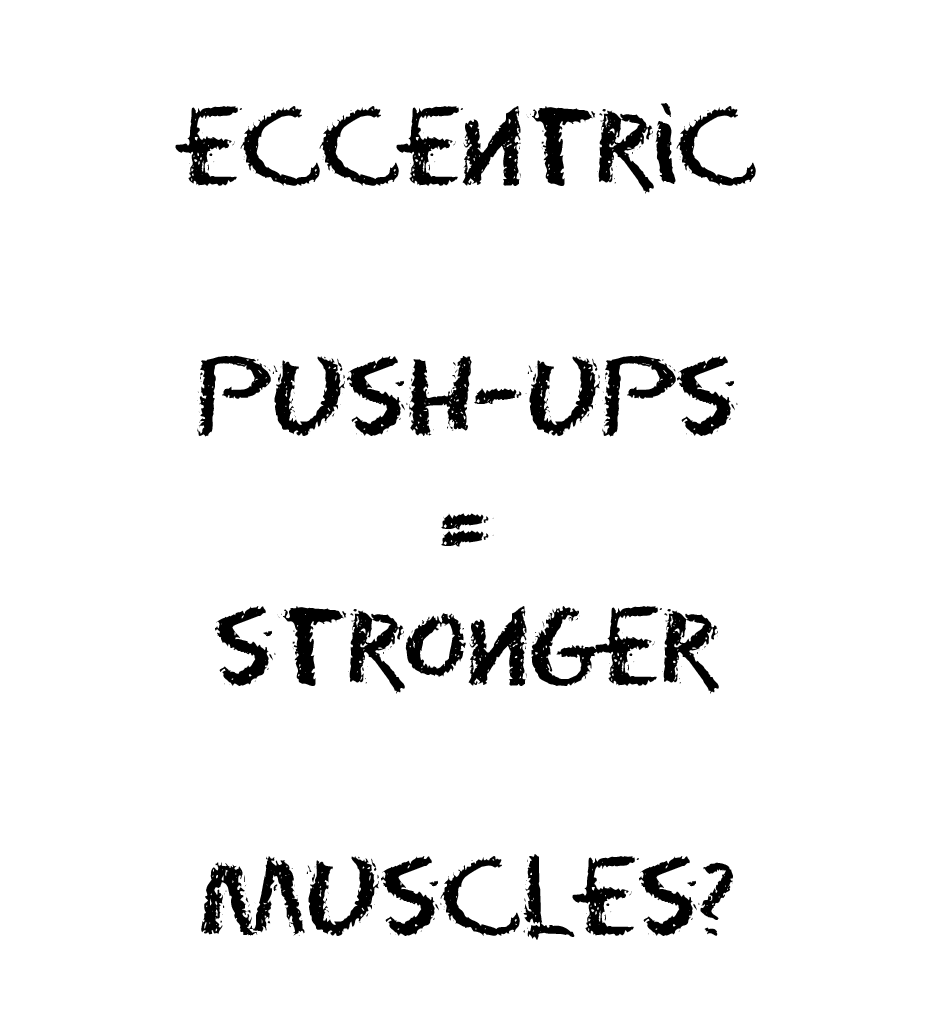The pushup is an excellent exercise for strengthening the upper body muscles of the chest (pectorals) and back of arms (triceps). This strengthening process can occur by performing any one of the three muscle actions. They are:
-Concentric (overcoming a load or raising the body from the down position)
-Eccentric (slowing down a load or lowering the body slowly to the down position)
–Static (Isometric) (holding the load at a desired position).
Because each muscle action provides a different stimulus to the muscle and produces a different adaptation, it is suggested that you incorporate each muscle action during your push-up training program for best results of improving overall muscular strength and endurance.
Examining the research, when eccentric training is used in an exercise program, the results seem to suggest that it is very favorable for the development of muscular strength.
This form of training is not just limited to the push-up exercise. Eccentric training applies to any activity that involves slowing down the lengthening process of the muscle action. Here I will explain how eccentric training will be used for the push-up exercise to help you increase your push-up performance during your push-up training program.
Eccentric Push-ups? Aren’t Concentric and Isometric Push-ups Sufficient?
Well, studies have shown that exercise programs that incorporate the use of eccentric muscle action may provide protection from injury or re-injury. Additionally, eccentric training performed at a higher intensity has been demonstrated to cause significantly greater increases in total strength compared to concentric training.
Currently, many of us are very familiar with the concentric muscle action and somewhat familiar with isometric muscle action. Unfortunately, the eccentric muscle action has not received much attention.
It is postulated that this may be the result of a number of reasons from lack of knowledge about its effectiveness to the difficulty of executing this movement.
Furthermore, there are different types of eccentric training.
One form is submaximal that involves manageable resistance (e.g. body weight during the push-up) and another form is maximal or supra-maximal that involves very heavy manageable (with assistance) weights (as in the bench press) equivalent to 105% or more of the maximum weight you can lift concentrically.
With regards to the bench press, the reason you are able to handle resistance with such high percentages is eccentric training uses less energy while allowing you to support greater weight.
Unlike the bench press however, performing eccentric pushups make you less susceptible to injury because the push-up eccentric muscle action is submaximal. In other words, your resistance is limited to your own body weight so you can control the speed of lowering your body to the ground surface or even incorporate an isometric muscle action (i.e. pulsing at certain points) in the process.
Although many people who perform eccentric training tend to be athletes or individuals who are heavily (no pun intended) into strength and conditioning, because the push-up is submaximal in nature, it is suitable and recommended for use by beginners compared to supra-maximal eccentric training.
Of course the recommended training routine for beginners will need to be slightly modified to meet their skill level. To assist individuals who are less experienced with eccentric push-ups, the training recommendations prescribed will be for beginners.
Advance participants may use the same recommendations by increasing the number of repetitions and/ or sets.
Before we cover the eccentric pushup training specifics, let’s mention the “good” (advantages) and the “bad” (disadvantages) of performing eccentric exercises.
The “Good” and “Bad” of Performing Eccentric Exercises
Good – Use of less energy and creates greater force which allows you to resist a greater amount of weight. The push-up will allow you to support your weight during the lowering phase even if you are unable to support your weight during the rising phase
– Older individuals are less susceptible to muscle injury compared to younger individuals during eccentric training. Speculations include slight decrease in range of motion and atrophy of muscles.
– Submaximal exercises have been shown to produce less Delayed Onset Muscle Soreness and may improve exercise compliance. The push-up is a submaximal exercise.
– Resistance exercise programs that incorporate the use of eccentric exercises will provide protection from injury or re-injury. Eccentric push-ups will allow for a slower lowering speed that will help to strengthen your upper extremity muscles using a different movement pattern (i.e. a slow downward movement pattern)
– Some individuals may experience less fatigue compared to concentric movements. Again, this may be the result of less energy being expended for lowering the body to the ground.
Eccentric training has been shown to increase your metabolism. This is evident when the eccentric push-up in followed by a concentric push-up as oppose to only performing the eccentric phase. Because this method is more beneficial, it is recommended.
Bad – Delayed Onset Muscle Soreness (DOMS) has been directly related to performing heavy bouts of eccentric loading exercises (e.g. lowering the weight during the supra-maximal bench press exercise). DOMS involves muscle tenderness that becomes apparent 8-10 hours after exercise and maximizes 24-48 hours after activity.
Fortunately for push-up enthusiasts, push-ups are submaximal. Additionally, studies have suggested that submaximal eccentric exercises produce less DOMS.
One method that has been shown to eliminate or reduce the level of DOMS is to perform an eccentric exercise and then wait for another week (or more) to perform the same exercise. During the second or subsequent performances of the eccentric loading exercise, the DOMS will be reduced or eliminated.
Recommendation for Use
Eccentric push-up training is ideal for individuals who would like to increase their upper body strength for performing more push-ups.
For example, this type of push-up is perfect for individuals who are following a push-up training program and have reached a training plateau.
Performing eccentric push-ups may stimulate the upper extremity muscles to make adaptations that may help you to perform more dynamic (regular) push-ups.
Additionally, if you are not able to perform a single push-up, eccentric push-up training is ideal for you as well.
For beginners, eccentric push-ups will give you an opportunity to support the loading of the upper body, which may lead to building stronger muscles so that you can perform concentric (regular) push-ups.
So, does Eccentric Push-ups Improve Strength? ABSOLUTELY.
Training Preparation and Routine
Before you attempt the suggested training routine, make sure you seek clearance from your physician or health care provider to ensure that you are in suitable condition.
O.k. now that we’ve gotten that out the way let’s perform some eccentric push-ups. First, if you are not able to perform a single push-up, it is suggested that you dedicate some of your early exercise sessions to performing the Isometric muscle action (supporting your body weight in the “up” push-up position for an extended period without lowering it).
Performing this exercise will strengthen your pectorals and triceps at that specific angle. This position will also help you to develop some core stability in preparation for performing the eccentric pushups.
Now before performing the eccentric push-ups, it is recommended that you perform some warm-up exercises. Based on your strength, here are a couple of warm-up recommendations.
If you can perform a regular push-up, warm-up by performing some modified (placing your knee on the ground) eccentric push-ups.
If you are unable to perform a knee push-up, warm up by performing some eccentric wall push-ups (face the wall, place both hands on the wall – arms slightly bent – take one step back with both legs – simulate the eccentric push-up movement while standing).
Individuals who warmed-up against the wall should perform the eccentric push-up in the modified position. Spend approximately 5 minutes warming up to include some aerobic type movements). Now you are ready!
Day 1 – For beginners, it is suggested that you perform 2 to 4 sets of as many eccentric push-ups (repetitions) as you are physically able. After the first set of eccentric push-ups, rest 1 to 2 minutes and repeat the process up to 3 more times.
At the conclusion of your workout, add the total number of eccentric push-ups (repetitions) performed and divide the total by the number of sets completed.
The number that you get should be your aim for the number of eccentric push-ups (repetitions) you will perform per set during the next workout session (within one week).
Sample Eccentric Push-up Training Routine
Day: Monday Warm-up exercises for 5 minutes
1. Perform as many eccentric loading push-ups as possible
a. Rest up to 2 minutes
2. Perform as many eccentric loading push-ups as possible
a. Rest up to 2 minutes
3. Perform as many eccentric loading push-ups as possible (optional)
a. Rest up to 2 minutes
4. Perform as many eccentric loading push-ups as possible (optional)
a. Rest up to 2 minutes
Divide total number of push-ups performed by the number of sets Answer = the number of eccentric push-ups you will attempt during the next workout
Continue with your regular workout schedule. Note your muscles may become sore within the next 8 to 24 hours. This is a normal response to this type of training. This soreness (if any) should not occur or will be reduced after your next eccentric workout session
The following Monday Perform 2 to 4 sets again of the eccentric push-up exercise.
As your muscles adapt to this type of training, you may increase the number of eccentric push-up sessions per week.
Important Points!
During your eccentric push-up execution, the rate of descent may be approximately 8 seconds. It is suggested that you use a metronome or cadence of some sort that has a consistent descent speed.
Counting may work as well however, as you become fatigued, it may be difficult to keep up the consistent lowering pace with your counting pace. The descent speed used in the video is approximately 8 seconds. The cadence used is called “Negative (Eccentric) Push-ups.
References
Aagaard, Per, “The Use of Eccentric Strength Training to Enhance Maximal Muscle Strength, Explosive Force (RDF) and Muscular Power – Consequences for Athletic Performance“, The Open Sports Sciences Journal, 2010, Volume 3, pp. 52-55.
Bubbico, Aaron and Kravitz, Len, Ph.D, October 2010 “Eccentric Training” Idea Fitness Journal, Volume 7, Number 10.
LaStayo, Paul C. Ph.D, Woolf, John M., Lewek, Michael D., Snyder-Mackler, Lynn, Trude-Reich, Lindstedt, Stan L. Ph.D, October 2003, “Eccentric Muscle Contractions: Their Contribution to Injury, Prevention, Rehabilitation, and Sport“, Journal of Orthopaedic & Sports Physical Therapy, Volume 33, Number 10, pp. 557-571.
Roig, M., O’Brien, K., Kirk, G., Murray, R., McKinnon, P., Shadgan, B., Reid, W.D., 2009, “The Effects of Eccentric Versus Concentric Resistance Training on Muscle Strength and Mass in Healthy Adults: a Systematic Review with Meta-Analysis“, British Journal of Sports Medicine, Volume 43, pp. 556-568.
We Love to Help Build Community

As an Amazon Associate I earn from qualifying purchases.

